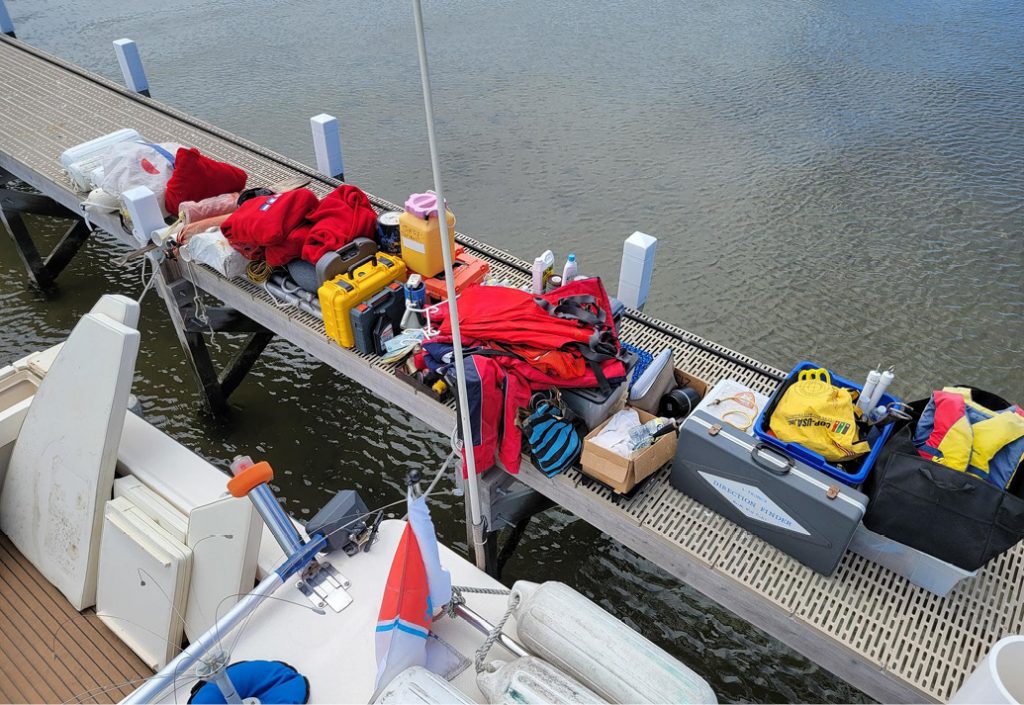Or “Physician, Heal Thyself”; Luke 4:23 *
As we (probably) all make New Year’s resolutions to go on a diet, we keep getting reminded that we are getting heavier as we get older. No matter where we turn, someone is telling us that we are getting fat and need to be thinner! Guess what? So are our boats! Yes, as boats get older, they get heavier and that has a lot to do about being less “sea-kindly” and more “tender” as they age (and our reflexes get slower – not a particularly good combination.)
And I recently thought that I’d test my theory on myself – as per the annual exercise, I emptied the patrol boat for deep cleaning and, rather than just blindly putting everything back, I reviewed the need for each item as it went back in.

Photo by myself
I threw out 60 lbs. of material that was otherwise ballast! With fuel always subject to geopolitical roiling, here are some examples of how the boat is getting heavier – and more expensive to drive.
New Stuff
We add things to our boat that weren’t there when we bought it. An ice chest may be added so we don’t have to lug one from the car. We add an additional ice chest so we can bring more ice so we can stay out longer and catch more fish (hopefully!) We pile up the cuddy cabin, aka the boat’s attic, with safety and fishing equipment so we don’t have to lug them from the car either.
And don’t forget that new 4-stroke engine you added – so much quieter, so much more fuel efficient and so much heavier per “horse of power” – at least 20% heavier would be my guesstimate, which makes a 400 lb 200hp 2-stroke weigh in at nearly 500 lbs as a 4-stroke state-of-the-art power plant. And the same hull sits in front of it.
Boats Get “Wrinkles” Too
More insidiously, through tiny cracks in the gelcoat, water seeps inside the hull and the boat gets 8 lbs heavier per gallon – and it seeps, generally, aft where the boat is naturally heavier per square foot of hull due to the engine. Thus making it harder to see over the bow when you gun the engine and start to “dig the hole” that getting up on plane gets you out of – and it’s now harder to get on plane, i.e., you have to go faster to get up on plane since the boat is heavier in the stern than when it was manufactured. An endless spiral.
Remedies
What to do? There are only two or three things you can do. First, get rid of anything that isn’t essential – see above! There are ten weekends in a summer. You aren’t going to boat on every one of those twenty days – unless you are between spouses and looking for one that wants to live on the boat with you! How much of a big deal is it to cart just the things you need – not everything you own all the time – from the car or the dock locker that you installed at the foot of your slip? Second, you may want to look into trim tabs – small “flaps” that are installed under your transom that’ll help you get up onto plane faster. What they save in fuel when “digging out of the hole” will quickly cover their costs. And don’t underestimate the safety factor that you’ll be able to see over the bow sooner. Third, you may need to change your prop!
The engine may be powerful enough to move your mini-warehouse, but it can’t turn the propeller any faster due to its pitch (angle that it cuts through the water.) Counter-intuitively, the lower the prop pitch, the better your shot out of the hole. However, this comes at a price: top speed. The lower pitch makes the engine reach maximum rpm at slower speeds. Conversely, a higher pitch will deliver greater top speeds, but slower acceleration. I recently went from a 3-blade prop to a 4-blade prop – same trade-off, up on plane sooner and more easily but lost about 10% of the wide-open-throttle (WOT) speed. For me, it was well worth it as I need to get out of the hole 100% of the time I apply thrust but rarely need to operate at WOT.
Talk to your dockmaster about who he or she uses when they re-engineer props for customers. Go see them and discuss your options. This is some art, some science, and some superstition. Talk it through with people who make a living engineering propellers. It will make a difference.
And remember, as the Romans used to say, “Medice, cura te ipsum.” * ■
If you are interested in being part of USCG Forces, email me at JoinUSCGAux@aol.com or go directly to the US Coast Guard Auxiliary “Flotilla Finder” at http://www.cgaux.org/units.php and we will help you “get in this thing . . .
The Captain of the Port and Sector Commander for U.S. Coast Guard Sector Long Island Sound is Captain Eva Van Camp Schang. CAPT Van Camp Schang is responsible for all active-duty, reservist and auxiliary Coast Guard personnel within the Sector. As a Commodore in the U.S. Coast Guard Auxiliary First District, Southern Region, Vin Pica works closely with CAPT Van Camp Schang and her staff to promote boating safety in the waters between Connecticut, Long Island and 200 nautical miles offshore. Sector Long Island Sound Command Center can be reached 24 hours a day at 203-468-4401.



